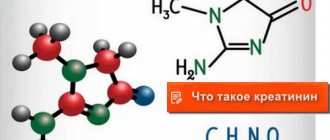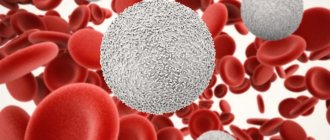Synonyms: binding peptide, connecting peptide, C-peptide, connectihg peptide.
Associated tests: blood glucose, urine glucose, glucose tolerance test, insulin, insulin antibodies, anti-islet cell antibodies (Anti-ICA), 24-hour urine C-peptide, glycated hemoglobin (HbA1c), genetic risk for hyperglycemia.
Quantitative determination of C-peptide in blood serum (plasma) is used for differential diagnosis of diabetes mellitus types 1 and 2, prognosis and control of its treatment. This test is also used to assess the functional activity of pancreatic β-cells and to diagnose certain pancreatic tumors.
Detailed description of the study
The pancreas secretes many hormones, among which insulin plays a key role in the metabolism of glucose in the body. This hormone is produced in the so-called islets of Langerhans - special areas of the gland that consist of beta cells. Insulin synthesis is a complex multi-step process, which results in the formation of an inactive substance - proinsulin. Its breakdown leads to the formation of the hormone insulin, which enters the blood and reaches organs, where it is involved in the transport of glucose into tissues.
C-peptide, or binding peptide, is necessary to connect the chains of the proinsulin molecule. This substance is secreted by beta cells of the pancreas when proinsulin is broken down into insulin. C-peptide plays a significant role in the correct folding of the insulin molecule and the formation of compounds (bridges) in it. There are suggestions that this peptide also has anti-inflammatory effects in various types of cells and protects them from destruction. After being released from the pancreas, it travels through the bloodstream to the liver and kidneys, then is excreted from the body.
The concentration of C-peptide reflects the level of insulin produced, which is convenient for detecting diabetes mellitus. This disease is associated with disruption of the endocrine function of the pancreas. In type 1 diabetes, the islets of Langerhans are destroyed due to autoimmune inflammation, in which the immune system mistakenly attacks a person's pancreas. In type 2 diabetes mellitus, the sensitivity of tissues to the action of insulin is initially impaired, and subsequently its formation decreases. The consequence of these processes is a persistent increase in blood glucose levels.
The clinical signs of type 1 and type 2 diabetes mellitus are similar. A person notices constant thirst, urination becomes frequent even at night, appetite increases, and weight can either increase or decrease. Damage to the smallest vessels and nerves throughout the body due to a long-term increase in the concentration of glucose in the blood contributes to decreased vision, damage to the skin, cardiovascular, nervous system, and kidneys.
There are two situations in which it is necessary to study C-peptide levels - assessing insulin production in patients with diabetes and studying the causes of hypoglycemia (low glucose levels) on an empty stomach.
Diabetes mellitus is characterized by hyperglycemia (increased blood glucose concentrations). Beta cell death causes insulin and C-peptide deficiency, which is mainly observed in type 1 diabetes. Although type 2 diabetes mellitus is caused by insulin resistance, it also manifests itself clinically only when the secretion of insulin and C-peptide is impaired. Decreased C-peptide levels in both types of diabetes mellitus correspond to beta cell failure and predict the need for insulin therapy.
In people with fasting hypoglycemia and concomitant increases in insulin concentrations, differential diagnosis should be made between various conditions, including insulinoma and other pancreatic tumors, sulfonylurea therapy, and autoimmune insulin syndrome (Hirata disease). C-peptide levels increase only in the presence of insulinoma and sulfonylurea therapy, but do not change in Hirata disease.
C-Peptide
What is C-peptide?
C-peptide (from the English connecting peptide, “connecting peptide”) is a fragment of the proinsulin molecule, as a result of the cleavage of which insulin is formed.
Insulin is produced by beta cells of the pancreas and stored in them as proinsulin. In the proinsulin molecule between the alpha and beta chains there is a fragment consisting of 31 amino acid residues - a connecting peptide or C-peptide. When blood glucose levels increase, proinsulin is enzymatically broken down into insulin and C-peptide. Together with the resulting insulin, C-peptide is released into the bloodstream. Insulin and C-peptide are secreted into the blood in equimolar quantities. Insulin and C-peptide concentrations are closely correlated but not identical. The half-life of C-peptide (20 minutes) in the blood is longer than that of insulin (4 minutes). Therefore, the C-peptide/insulin ratio is approximately 5:1. Abnormally low levels of C-peptide may indicate a decrease in insulin production; excessively high levels may indicate the possible presence of insulinoma.
The C-peptide level is a more stable indicator of insulin secretion than the rapidly changing level of insulin itself. Another advantage of the C-peptide assay is that it distinguishes endogenous insulin from insulin introduced into the body externally by injection, since, unlike insulin, C-peptide does not cross-react with insulin antibodies. Considering that therapeutic insulin preparations do not contain C-peptide, its determination in blood serum makes it possible to assess the function of pancreatic β-cells in patients with diabetes mellitus receiving insulin.
Monitoring the level of C-peptide is especially important in patients after surgical treatment of insulinoma; detection of increased levels of C-peptide in the blood indicates metastases or relapse of the tumor.
With pathology of the liver and kidneys, the ratio of the concentrations of C-peptide and insulin in the blood may change.
Indications for use:
- Differential diagnosis of diabetes types I and II;
- Differential diagnosis of hypoglycemic conditions (diagnosis of insulinoma, suspicion of artificial hypoglycemia);
- Choice of treatment tactics for diabetes mellitus;
- Assess residual beta cell function before interrupting insulin therapy; detection and monitoring of remission after elimination of glucotoxicity (diabetes in obese adolescents);
- Assessment of insulin secretion in liver diseases;
- Control after removal of the pancreas;
- Examination of women with polycystic ovary syndrome.
Impact on the result. Possible reduction in values:
- stressful state;
- poisoning, incl. alcohol.
general characteristics
A product of the breakdown of proinsulin into C-peptide and insulin. The release of C-peptide and insulin by beta cells of the pancreas occurs in equal quantities, but C-peptide is biologically inactive. Unlike insulin, most of the C-peptide is degraded in the kidneys and is partially excreted in the urine. Does not bind to liver receptors and more accurately reflects beta cell secretion. The result is not affected by insulin intake, which is important in patients on insulin therapy and in the presence of circulating antibodies to insulin.
The test will allow your doctor to:
- Conduct a differential diagnosis of type 1 and type 2 diabetes mellitus;
- Predict the course of diabetes mellitus;
- Conduct differential diagnosis of hypoglycemic conditions;
- To assess residual β-cell function in diabetics on insulin therapy;
- Identify and monitor remissions of diabetes mellitus (juvenile diabetes);
- Assess insulin secretion in liver diseases.
The study is recommended for:
- Dizziness;
- Weaknesses;
- Impaired or loss of vision;
- Obesity;
- Having relatives with type 2 diabetes mellitus;
- Suspicion of diabetes mellitus;
- Differential diagnosis of diabetes mellitus type 1 and type 2;
- Suspicion of artificial hypoglycemia;
- Myocardial infarction;
- Hypertensive crisis;
- Chronic renal failure;
- Impaired sensitivity of the limbs with the formation of ulcers.
Method:
Enzyme-linked immunosorbent assay (ELISA).
Sensitivity:
Not less than 15 pmol/l (45 ng/l).
Material for research:
Blood serum (plasma).
Where can I get tested for C-peptide?
The analysis can be submitted to the ELISA Medical Center.
Preparation:
- Last meal 8-10 hours before the test.
- Avoid alcoholic beverages 24 hours before donating blood, and do not smoke several hours before the test.
- Do not overeat on the eve of the test.
- Refuse to take medications before donating blood; if this is not possible, then warn your doctor.
As for the range of studies, at the ELISA Medical Center you can take screening tests for the prevention and early detection of diabetes mellitus. The complex includes tests for: insulin, C-peptide, glucose, glycosylated hemoglobin, calculated indicators - Homa ir index, Caro index.
C-peptide
Material for research: blood serum.
Research method: IECHL.
C-peptide is a fragment of the proinsulin molecule, as a result of the cleavage of which insulin is formed.
Insulin and C-peptide are secreted into the blood in equimolar quantities. The half-life of C-peptide in the blood is longer than that of insulin. Therefore, the C-peptide/insulin ratio is 5:1. Determination of the concentration of C-peptide in the blood allows us to characterize the residual synthetic function of beta cells in patients with diabetes mellitus. C-peptide, unlike insulin, does not cross-react with insulin antibodies. Considering that therapeutic insulin preparations do not contain C-peptide, its determination in blood serum makes it possible to assess the function of pancreatic beta cells in patients with diabetes mellitus receiving insulin.
In a patient with diabetes, the value of the basal level of C-peptide and especially its concentration after a glucose load (during a glucose tolerance test) makes it possible to determine the presence of insulin resistance or sensitivity, determine the phases of remission and thereby adjust therapeutic measures. In clinical practice, determination of C-peptide in the blood is also used to determine the cause of hypoglycemia. In patients with insulinoma, the concentration of C-peptide in the blood is significantly increased. Monitoring the level of C-peptide is especially important in patients after surgical treatment of insulinoma; detection of elevated levels of C-peptide indicates metastases or tumor relapse.
Diseases and conditions in which the concentration of C-peptide may change
Increase in C-peptide concentration
- Insulinoma
- Chronic renal failure
Decreased C-peptide concentration
- Administration of exogenous insulin
- Diabetes mellitus type I and II
Attention to the Patient
- the concept of norm is not absolute and has no clear boundaries
- Normal reference values often vary significantly among people of different sexes and age groups.
Remember that only your attending physician, who knows your medical history well, can provide a clear interpretation of the test results.
To the attention of the DoctorReference limits for healthy and sick people are often largely the same. You can contact your BRIGHT-Bio consultant for more information. |
The content of C-peptide in serum is normal: 1.1 – 4.4 ng/ml.
Indications
- Diagnosis and treatment of patients with diabetes of both types, prognosis of the course of the disease, assessment of the risks of complications;
- Differential diagnosis of diabetes types 1 and 2;
- Study of the functioning of beta cells in patients with diabetes during treatment with insulin drugs;
- Determination of remission in adolescents with juvenile diabetes;
- Management of pregnancy and prediction of pathologies of fetal development in patients with diabetes (including gestational);
- Diagnosis and monitoring of therapy for insulinoma (hormone-secreting tumor of the pancreas);
- Early detection of artificial hypoglycemia (lowering sugar levels in the case of non-therapeutic use of insulin or sulfonylurea drugs);
- Differential diagnosis of other causes of hypoglycemia and associated syndromes;
- Diagnosis and treatment of infertility;
- Suspicion of polycystic ovary syndrome (pathology of the structure and functioning of the ovaries with menstrual irregularities);
- Impaired insulin production due to pathologies of the liver and kidneys;
- Rehabilitation of patients after removal of the pancreas.
Often, an endocrinologist prescribes an analysis if it is necessary to transfer a patient with type 2 diabetes (non-insulin dependent) to insulin therapy. A C-peptide test can also be prescribed to reliably determine the type of diabetes. For example, if the results indicate a decrease in the level of C-peptide in the blood, then the patient is more likely to have type 1 diabetes and vice versa.
The results of the C-peptide test are interpreted by an endocrinologist, gynecologist, oncologist or therapist.
How to decipher the result?
The result is assessed solely by your doctor. Not only the connection peptide analysis is taken into account, but also other studies. Reference values are considered to be 260–1730 pmol/l. An important point - do not rely on generally accepted norms, because each organism is individual.
Increased levels: insulinoma, type 2 diabetes, hypoglycemia, renal failure, taking certain medications, polycystic ovary syndrome.
Decreased levels: type 1 diabetes, insulin therapy, alcoholic hypoglycemia, stress conditions.
Patient preparation rules
Standard conditions:
In the morning before 11-00, on an empty stomach, after 8-12 hours of fasting.
Important:
Agree with your doctor about the possibility of performing it on an empty stomach and/or after a load of glucose or food. Possible: During the working day of the diagnostic department of ML “DILA”. A break of at least 6 hours after eating (fatty foods should be excluded).
You can add this study to your cart on this page








